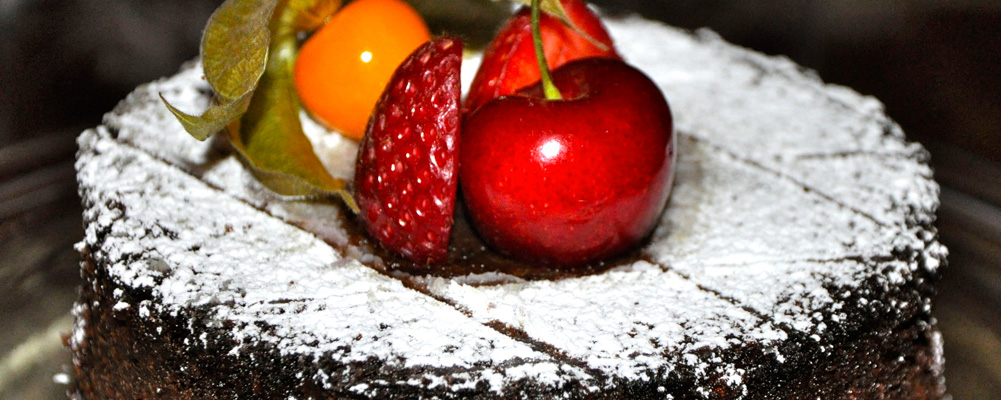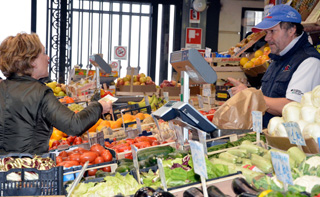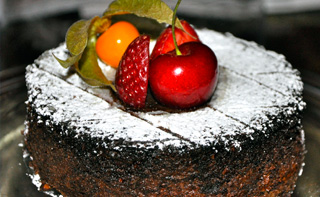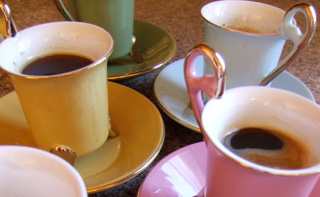Eating In Italy

Colazione, Pranzo, Cena ~ Breakfast, Lunch & Dinner
Eating In Italy comes in three parts: prima colazione-breakfast,
pranzo-lunch, and cena-dinner, between which, people tide themselves over with a spuntino-snack.
Prima colazione, breakfast, and includes an espresso or cappuccino at the bar, with a fresh-baked cornetto,-a sweet pastry filled with marmellata or chocolate. Brioches are another popular breakfast food.
Pranzo, lunch, the largest meal of the day and often includes an antipasto-appetizer, primo- first course, secondo,-second course,
and almost always a dolce – dessert, followed by a caffè.
Cena, dinner, is generally lighter and might consist of either a primo or secondo on its own.
A glass of vino bianco, white or vino rose, red wine, always accompanies lunch and dinner.
Each region of Italy has its own style of cooking, and some recipes even vary from town to town. One common factor that is always respected is the use of only seasonal produce. The Italian philosophy is of eating using only fresh products, and keeping things simple. Italians never eat alone (indeed, they do very little alone!), so at any lunch or dinner, it is not unusual to find an assortment of friends and family all eating together around the table. Buon appetito!
Antipasto, Appetizer
Appetizers in Italy vary by region and season, but are always small portions that stimulate your appetite, and are never meant to fill you up. Typical antipasti include bruschetta, toasted bread garnished with juicy red tomatoes tossed with sea salt, oregano, and extra-virgin olive oil. In Tuscany, these bite-sized toasted bread creations are called crostini,– and can include a variety of vegetable, herb & cheese or liver garnishes. Antipasti also can include, affettati,-local air-dried meats such as prosciutto and salame served with fresh melon, figs or mozzarella. Vegetable appetizers, based on what’s in season, include grilled zucchini, eggplant, peppers, or pumpkin, drizzled with sea salt, vinegar and extra-virgin olive oil. Fiori di zucca, succulent bright orange zucchini flowers lightly filled with fresh ricotta, dipped in egg and flash fried in sunflower oil are also very popular. Traditional arancini, small and delicatelyfried rice balls filled with a small nibbles of cheese are an old-world tradition, especially in the south, as are crocché, small bites of potato puree, blended with cheese & ham and golden fried. Throughout Italy, fish antipasti include: alici marinate -marinated anchovies; frittura mista – mixed fried fish, perhaps squid, tiny white fish or octopus; or calamari Lucia – small fresh calamari slow-cooked in a rich tomato sauce with capers and black olives; focaccia – a flat wood-oven baked bread, lightly salted and dusted with rosemary; or insalata Caprese,-farm fresh mozzarella layered with fresh basil and garden tomatoes. And for a variety of flavors try the antipasto misto, a sampling of the various local meats and vegetables in season.
Primo, First Course
First courses in Italy usually mean pasta! A primo may include, pasta, risotto, or polenta – a corn meal grain. Serving sizes are on the small side, as the primo is always followed by a secondo.
A Note On Pasta
Pasta, arguable Italy’s most important dish, comes in all shapes and sizes, can be fresh or dried, and has a specific sugo, sauce it goes with. Chefs and cooks are very serious about cooking specific pastas with their appropriate sauces.
Long pastas include fettuccine, tagliatelle, spaghetti, tagliolini, bavette, linguine, vermicelli, bucatini, pappardelle – all of which are prepared with a basic tomato, basil and sprinkled with fresh grated cheese. Other sauces for long pasta might include spinaci, funghi & formaggio – spinach, mushroom & cheese; nero di sepia – squid ink; vongole – small local sea clams; aglio e olio – sautéedgarlic, extra-virgin olive oil and red chili pepper, all of which are popular in different regions. Short pastas include farfalle – butterflies, fusilli –twists, orecchiette – little ears, conchiglie – shells, trofie – narrow twists, penne – tubes or rigatoni – large tubes, and can be served with shrimp, meat, sausage or veal cooked in slow-stewed sauces. Then there is also lasagna – a flat pasta which is layered with cheese, meat or vegetables. Filled pastas included, tortellini, ravioli and cannelloni. These plump hand-made creations can be filled with mozzarella & eggplant, or orange squash & ricotta. And everyone’s favorite, gnocchi – dumplings made with potato and semolina, hand-rolled and boiled to perfection, garnished with tomato, basil and mozzarella. Gnocchi alla Sorrentina– takes it one step further and bakes it. There are over 1000 types of pasta in Italy, each with its roots in a different region. Bucatini – thick hollow spaghetti, are typically Roman; scialatielli – thick, wavy hand-made pasta are from Campania, and tortellini – cheese-filled delightshail from Emilia-Romagna.
Risotto, a slow cooked rice dish can be prepared alla pescatora– with fresh local seafood and a light tomato sauce; ai funghi – with mushroom and cheese; con la zucca – with pumpkin; carciofi – artichokes; or con cavolo – cabbage. From Venice comes risi e bisi – slow-cooked rice and peas; from Tuscany, faro – emmer wheat, a healthy grain normally served with vegetables; and from all over Italy, polenta – a yellow cornmeal that is generally layered with tomato and meat sauce. All of these old-world dishes were once thought of as “poor man’s dishes”, but are now enjoying a much deserved return to popularity, both in Italy and abroad.
Secondo, Second Course
The secondo, the main course, might for example consist of fresh fish, such as orata – sea bass served in aqua pazza – crazy water with fresh local tomatoes, garlic and olive oil; or spiedini di mare – a mix of shrimp, mullet and sword fish layered between lemon leaves and stacked on a stick for grilling, garnished with a drizzle of lemon juice. Then there is vitello al limone – pan-fried veal with fresh lemon juice; costolette alla valdostana – baby veal with Fontina cheese layered with ham; or costolette alla Milanese – slices of veal dragged in flour and pan-fried. Traditional polpete -meatballs for example, are served as a second course, and never mixed with pasta, though the sauce they are cooked in is. The secondo is always the main dish of the meal.
Contorni / Side Dishes
The contorno – side dish, pairs up with the secondo and generally consists of vegetables. Italians often have a simple green salad to accompany their secondo. Favorite contorni include fagiolini – farm fresh green beans boiled and drizzled with lemon juice and extra-virgin olive oil; broccoli – a hearty green leaf vegetable whose tasty bitterness pairs perfectly with salsiccia -grilled sausage; melanzane ai funghetti – sautéed eggplant; or peperoni gratinati,– sweet red peppers oven-roasted and sprinkled with breadcrumbs. Contorni vary by season.
Dolce, Dessert
Italian dolce is a world of ‘sweet art.’ In Italy, dessert is a ritual, and no lunch or dinner is complete without it! Desserts include a score of sweetmeats from biscotti to gelato, and everything in between. Italy’s dolci, which are a must, include: tiramisu, caffè soaked vanilla cake layered with fresh whipped cream, mascarpone cheese and topped with chocolate powder. There are oven-baked almond biscotti dipped in Vin Santo, a sweet white Tuscan wine; fragoline, wild strawberries topped with fresh whipped cream; profiteroles, choux pastries filled with whipped cream and topped with chocolate or lemon cream; semifreddo, ‘semi-cold,’ a summertime ice-cream cake made with pralines; crostatine, fruit tarts of strawberries, apples, peaches or pears, depending on the season, and baked in a soft sweet crust; or simple fresh fruits of strawberries, peaches, nectarines, kiwi, pineapple, watermelon, apple, pear, and mandarin oranges, sliced and mixed for colorful-macedonia.
Caffè
Caffè caps off each meal, sometimes spiked with a little Sambuca or Grappa and always followed by apasseggiata, a little walk to work off all that delicious Italian food!












